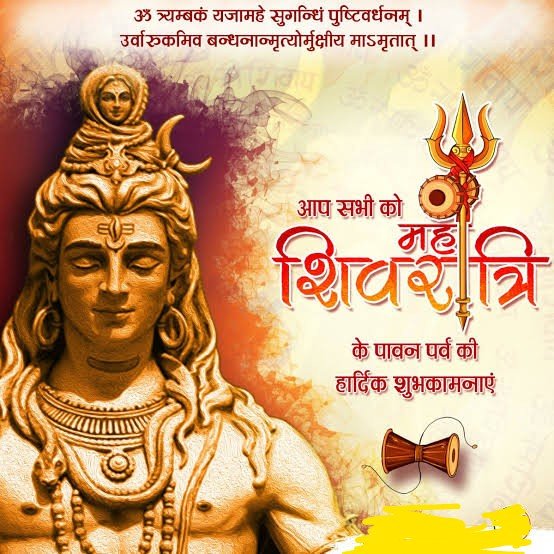Maha Shivratri 2022: Shivratri is an auspicious Hindu festival, Maha Shivratri is the most important and celebrated among the 12 Shivaratri celebrated in a year. Shivratri is an amalgamation of two words, Shiva and Ratri, where Shiva means ‘Lord Shiva’ and Ratri means night.

Together with Shivaratri i.e. the night of Lord Shiva. Every year, Mahashivratri is celebrated as the convergence of the powers of Shiva and Shakti. On this day devotees worship Lord Shiva, observe strict fasting and perform various religious works to please Lord Shiva and on the next day i.e. on Chaturdashi.
Chaturdashi Tithi during Krishna Paksha in Magha month is known as Maha Shivratri as per South Indian calendar. However, as per the North Indian calendar, the monthly Shivaratri in the month of Phalguna is known as Maha Shivratri.
The word Shivaratri is derived from the combination of two words Shiva and Ratri, where Shiva means ‘Lord Shiva’ and Ratri means night. Hence Shivratri means the night of Lord Shiva.
This year this holy festival will be celebrated on 1st March 2022.
Maha Shivratri 2022: Worship Timings
- Nishita Kaal Puja Timings: 12:08 AM to 12:58 AM, March 02 (Duration – 00 hrs 50 mins)
- Shivratri Paran Time on 2nd March 2022 – 06:45 AM, 2nd March 2022
- Night Prahar Puja Timings – 06:21 PM to 09:27 PM
Ratri II Prahar Puja Timings – 09:27 PM to 12:33 AM, 02 March
Ratri Tritiya Prahar Puja Timings – 12:33 AM to 03:39 AM, 02 March
Ratri Chaturthi Prahar Puja Timings – 03:39 AM to 06:45 AM, 02 March
Chaturdashi date start – March 01, 2022 at 03:16 am
Chaturdashi date ends – 01:00 am March 02, 2022
Significance of Maha Shivratri
Shivratri fast is popular since ancient times. According to the scriptures, Goddess Lakshmi, Indrani, Saraswati, Gayatri, Savitri, Sita, Parvati, Rati also fasted on Shivaratri.
On Maha Shivratri, unmarried women observe this fast for marriage and married women observe this fast to maintain peace and tranquility in their married life. However, the devotees who wish to observe the monthly Shivaratri fast can start it from the day of Maha Shivratri and continue it for a year. The day symbolizes the remembrance of overcoming darkness and ignorance in life and in the world. It is said that Maha Shivaratri marks the anniversary of the cosmic dance performed by Lord Shiva.
Maha Shivratri Rituals
On Maha Shivratri, devotees wake up before sunrise and take a bath, preferably in the holy waters of the Ganges River. Thereafter, the devotees visit the nearest Shiva temple and perform Jalabhishek on the Shivling with six different ingredients including milk, curd, honey, ghee, sugar and water. After that devotees offer Akshat, Abir, Gulal etc. to the Shivling.
Devotees light incense sticks, lamps, offer white cloth, sweets, any five, fruits and Panchamrit. On Maha Shivratri, this worship of Lord Shiva continues day and night.
Devotees break their fast by eating prasad the next morning of Maha Shivratri.
Maha Shivratri Vrat Katha
According to Hindu mythology, from the birth of Lord Shiva to the legend of Neelkanth and the marriage of Goddess Parvati, there are many stories and beliefs on why we celebrate Mahashivratri.
It is believed that after the death of Sati, Lord Shiva went into deep meditation. Sati incarnated as Parvati. Hence, Mahashivratri marks the union of Shiva and Parvati on the 14th day of the dark fortnight in the month of Phalguna.
According to Hinduism, it is also believed that on this night Shiva performed the dance of protection, creation and destruction.
However, according to some, Maha Shivratri is a thanksgiving ceremony. This story talks about the time when Lord Shiva saved the world. He drank and instead of swallowing the poison put it in his throat which turned his throat blue. From there the name ‘Neelkanth’ originated.
There was a king named Sundarsen. Once he went hunting in the forest with his dogs. When he could not find any animal even after working hard all day, suffering from hunger and thirst, he climbed a tree other than a pond to retire for the night.
Under the bel tree there was a Shivling which was covered with bilva leaves. Meanwhile, while plucking some twigs, some of them accidentally fell on the Shivling. In this way, the hunter by mistake also fasted and incidentally he also offered bilvapatra on the Shivling.
After a few hours had passed in the night, a deer came there. When the hunter shot an arrow at the bow to kill him, a bilva leaf broke and fell on the Shivling. Thus the worship of the first Prahar was also done unknowingly. The deer also disappeared in the wild bushes.
After some time another deer came out. Seeing him, the hunter again shot an arrow at his bow. This time too, in the second half of the night, bilvapatra leaves and water fell on the Shivling and the Shivling was worshipped. The deer fled.
After this a deer of the same family came there, this time the same thing happened and in the third hour Shivling was worshipped. That deer also ran away.
Now for the fourth time the deer along with its sheep and goats came there to drink water. The hunter was very happy to see all of them together and when he again shot his bow, some part of the bilvapatra fell on the Shivalinga, thereby worshiping the Shivalinga again in the fourth stroke.
In this way the hunter remained hungry and thirsty throughout the day and remained awake throughout the night and all four of them unknowingly worshiped Shiva, thus completing the fast of Shivaratri.
Later when he died, Yamraj’s messengers tied him in a loop and took him to Yamlok, where Shivaji’s ganas fought with Yamadoot and freed him from the loop. In this way Nishad joined the beloved ganas of Lord Shiva.

